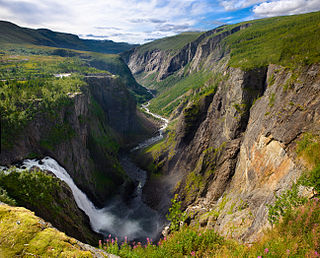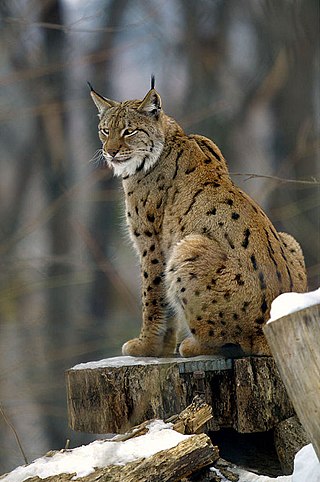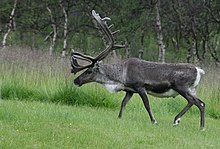
The moose or elk is the world's tallest, largest and heaviest extant species of deer and the only species in the genus Alces. It is also the tallest, and the second-largest, land animal in North America, falling short only of the American bison in body mass. Most adult male moose have broad, palmate antlers; other members of the deer family have pointed antlers with a dendritic ("twig-like") configuration. Moose inhabit the circumpolar boreal forests or temperate broadleaf and mixed forests of the Northern Hemisphere, thriving in cooler, temperate areas as well as subarctic climates.

The reindeer or caribou is a species of deer with circumpolar distribution, native to Arctic, subarctic, tundra, boreal, and mountainous regions of Northern Europe, Siberia, and North America. It is the only representative of the genus Rangifer. More recent studies suggest the splitting of reindeer and caribou into six distinct species over their range.

Eidfjord is a municipality in Vestland county, Norway. The municipality is located in the traditional district of Hardanger. The administrative centre of the municipality is the village of Eidfjord, where the majority of the municipal population lives. The other major population centre in the municipality is the village of Øvre Eidfjord.

The muskox is a hoofed mammal of the family Bovidae. Native to the Arctic, it is noted for its thick coat and for the strong odor emitted by males during the seasonal rut, from which its name derives. This musky odor has the effect of attracting females during mating season. Its Inuktitut name "umingmak" translates to "the bearded one".

Børgefjell National Park is an undeveloped national park in Norway, straddling the border between Trøndelag and Nordland counties, along the border with Sweden. The park is undeveloped with few trails or other facilities for visitors. Visitors can hike for extended periods without seeing another person. The 1,447-square-kilometre (559 sq mi) park was originally established in 1963, and it was enlarged in 1973 and 2003. It now includes land in the municipalities of Hattfjelldal, Grane, Namsskogan, and Røyrvik.

The migratory woodland caribou refers to two herds of Rangifer tarandus that are included in the migratory woodland ecotype of the subspecies Rangifer tarandus caribou or woodland caribou that live in Nunavik, Quebec, and Labrador: the Leaf River caribou herd (LRCH) and the George River caribou herd (GRCH) south of Ungava Bay. Rangifer tarandus caribou is further divided into three ecotypes: the migratory barren-ground ecotype, the mountain ecotype or woodland (montane) and the forest-dwelling ecotype. According to researchers, the "George River herd which morphologically and genetically belong to the woodland caribou subspecies, at one time represented the largest caribou herd in the world and migrating thousands of kilometers from boreal forest to open tundra, where most females calve within a three-week period. This behaviour is more like barren-ground caribou subspecies." They argued that "understanding ecotype in relation to existing ecological constraints and releases may be more important than the taxonomic relationships between populations." The migratory George River caribou herd travel thousands of kilometres moving from wintering grounds to calving grounds near the Inuit hamlet of Kangiqsualujjuaq, Nunavik. In Nunavik and Labrador, the caribou population varies considerably with their numbers peaking in the later decades of each of the 18th, 19th and 20th centuries. In 1984, about 10,000 caribou of the George River herd drowned during their bi-annual crossing of the Caniapiscau River during the James Bay Hydro Project flooding operation. The most recent decline at the turn of the 20th century caused much hardship for the Inuit and Cree communities of Nunavik, who hunt them for subsistence.

The Peary caribou is a subspecies of caribou found in the High Arctic islands of Nunavut and the Northwest Territories in Canada. They are the smallest of the North American caribou, with the females weighing an average of 60 kg (130 lb) and the males 110 kg (240 lb). In length the females average 1.4 m and the males 1.7 m.

The barren-ground caribou is a subspecies of the reindeer that is found in the Canadian territories of Nunavut and the Northwest Territories, in northern Alaska and in south-western Greenland. It includes the Porcupine caribou of Yukon and Alaska. The barren-ground caribou is a medium-sized caribou, smaller and lighter-colored than the boreal woodland caribou, with the females weighing around 90 kg (200 lb) and the males around 150 kg (330 lb). However, on some of the smaller islands, the average weight may be less. The large migratory herds of barren-ground caribou take their names from the traditional calving grounds, such as the Ahiak herd, the Baffin Island herds, the Bathurst herd, the Beverly herd, the Bluenose East herd, the Bluenose West herd, the Porcupine herd and the Qamanirjuaq herd.

The Dawson's caribou, also known as the Queen Charlotte Islands caribou was a population of woodland caribou that once lived on Graham Island, the largest of the islands within the Haida Gwaii archipelago, located off the coast of British Columbia, Canada.

Reindeer hunting in Greenland is of great importance to the Greenlandic Inuit and sports hunters, both residents and tourists. Reindeer (caribou) are an important source of meat, and harvesting them has always played an important role in the history, culture, and traditions of the Greenlandic Inuit. Controlled hunting is important for the welfare of reindeer, the quality of life for Inuit, both as food, and part of their culture and Greenlandic culture in general, and the preservation of tundra grazing areas. Therefore, scientific research is regularly performed to determine the quotas needed to maintain a proper ecological balance.

The Finnish forest reindeer(Rangifer tarandus fennicus, also known as Eurasian or European forest reindeer is a rare subspecies of the reindeer native to Finland and northwestern Russia. They are found primarily in Russian Karelia and the provinces of North Karelia, Savonia and Kainuu in Finland, though some range into central south Finland. They are distinct from the semi-domesticated mountain reindeer in their larger size, longer legs and preference for dense boreal forest habitat, where they are rarely seen by humans, over the open tundra. The Finnish herd migrates seasonally back and forth across the long Russo-Finnish border.

Korkeasaari Zoo, also known as Helsinki Zoo, is the largest zoo in Finland, located in Helsinki. The zoo was first opened in 1889. Today it is operated by a nonprofit foundation.

The North Central Rockies forests is a temperate coniferous forest ecoregion of Canada and the United States. This region overlaps in large part with the North American inland temperate rainforest and gets more rain on average than the South Central Rockies forests and is notable for containing the only inland populations of many species from the Pacific coast.

The Svalbard reindeer is a small subspecies or species of reindeer found on the Svalbard archipelago of Norway. Males average 65–90 kg (143–198 lb) in weight, females 53–70 kg (117–154 lb), while for other reindeer generally body mass is 159–182 kg (351–401 lb) for males and 80–120 kg (180–260 lb) for females.

The boreal woodland caribou, also known as Eastern woodland caribou, boreal forest caribou and forest-dwelling caribou, is a North American subspecies of reindeer found primarily in Canada with small populations in the United States. Unlike the Porcupine caribou and barren-ground caribou, boreal woodland caribou are primarily sedentary.

Reindeer in Russia include tundra and forest reindeer and are subspecies of Rangifer tarandus. Tundra reindeer include the Novaya Zemlya (R.t.pearsoni) and Sápmi subspecies and the Siberian tundra reindeer.

The northern lynx is a medium-sized subspecies of the Eurasian lynx.
Caribou herds in Canada are discrete populations of seven subspecies that are represented in Canada. Caribou can be found from the High Arctic region south to the boreal forest and Rocky Mountains and from the east to the west coasts.

The reindeer is a widespread and numerous species in the northern Holarctic, being present in both tundra and taiga. Originally, the reindeer was found in Scandinavia, eastern Europe, Russia, Mongolia, and northern China north of the 50th latitude. In North America, it was found in Canada, Alaska, and the northern contiguous USA from Washington to Maine. In the 19th century, it was apparently still present in southern Idaho. It also occurred naturally on Sakhalin, Greenland, and probably even in historical times in Ireland.




















